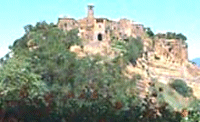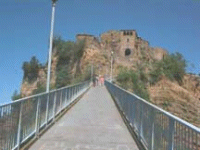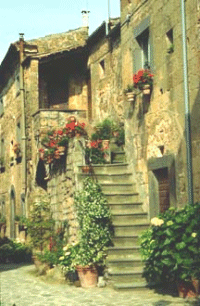
We're an all volunteer website and need your help to keep going. Here are five ways you can contribute: 1 Donate 2 Buy something 3 Submit a story 4 Volunteer 5 Advertise

New in the gift shop, virtualitalia.com logo wear and use items! 
|
PLEASE NOTE: We are experiencing unexpected
technical difficulties caused by our web host. We apologize for
the inconvenience. During your visit you may experience service
and page interruptions - we are in the process of fixing everything and hope to be
fully back on our feet soon.
a modern bridge to ancient latium
Civita is an ancient, pre-Roman settlement going back to Etruscan times which is today a tiny heirloom pearl in the drawer of the larger "modern" Renaissance town of Bagnoregio. Hardly an archeological ruin, Civita has been continuously inhabited since the pre-Roman Etruscans settled here. It's a bit off the beaten path in the northern Latium province which includes Rome; but yet close to Perugia in the Umbrian province further north. The Etruscans and succeeding populations probably relished the safety from invaders afforded by its 360 degree isolation atop a high stone outcropping thrusting up dramatically from its craggy valley.
I was immediately struck by the quiet and calm where a few stone houses in ruins lost the battle to erosion -- Civita's most persistent foe on its borders. The dark paving stones echoed the sky on this damp March morning and formed the one principal pathway which meanders to every quarter of this tiny village. The only restaurant probably would remain closed until summer when explorers might venture beyond grand tour boundaries. To my delight, the ubiquitous cats of Italy were in residence here and served as the town's ambassadors. More curious, however, was an elder citizen gazing from her window perch beyond the crack in the lace curtains -- just wide enough for me to view the impressive wood beamed ceiling above her. She was the first of only two people I was to witness during two trips across the bridge. The other was the priest perched on his tall ladder busy restoring the stucco walls of his church's vestibule. A pulpit perch would have to wait for a more populous time.
Continuing down the path I passed earthenware pots planted with evergreens and vines caressing the many archways joining tile-roofed houses lining the small side lanes. At the end of one of these bi-ways my camera documented the thatched roof of a charming one-story outbuilding. With so much history here, I instinctively knew that Civita's good urban design was actually 'design by default' over the ages. With so little land the main objective surely was to be efficient. But somehow the intimate human scale of all that is built or adorned here cannot be dismissed so easily. The spirit of a continuous coexistence was at work here. The walkway continued in this land without automobiles or vespers. I arrived at an exposed edge guarded by moss and lichen covered boulders which together acted as a pedestrian guard rail against the precipitous drop to the valley floor. Spring had claimed this reposeful spot overlooking gentle hills with its patchwork of green against the denuded surfaces claimed by ever-present erosion in this region. The bright yellow of fresh new leaves on a lithesome tree silhouetted against faint outlines of distant villas on the landscape. Colorful flowers celebrated the season from their protected anchors within the seams of timeless masonry walls. A split surface of a door within the wall was just wide enough to witness the well tended private garden -- a precious bit of paradise broken away from an already very small world.
|
© 1998-2005 by virtualitalia.com unless otherwise noted
 I was sufficiently intrigued with the accounts of Civita di Bagnoregio by
travel writer,
I was sufficiently intrigued with the accounts of Civita di Bagnoregio by
travel writer,  The approach to the town is a mixed message. Commanding your attention in
the distance is Civita's quintessential Medieval gate of weathered soft brown
stone graced by small heraldic seals. But, what is this distracting, steel
footbridge traversing the moat-like valley between Civita and Bagnoregio?
The question is quickly lost because beyond this portal of time the bridge,
Bagnoregio, and the world for that matter, are well behind you.
The approach to the town is a mixed message. Commanding your attention in
the distance is Civita's quintessential Medieval gate of weathered soft brown
stone graced by small heraldic seals. But, what is this distracting, steel
footbridge traversing the moat-like valley between Civita and Bagnoregio?
The question is quickly lost because beyond this portal of time the bridge,
Bagnoregio, and the world for that matter, are well behind you.
 The church's Boroque facade served as one of three walls forming a handsome
square which could have easily been used as a market or forum. The worn
doors proved yet another portal to Civita's earlier days with its massive,
medieval columns of gray stone which meet the massive beams carrying the
roof. It seemed colder and darker here than outside.
The church's Boroque facade served as one of three walls forming a handsome
square which could have easily been used as a market or forum. The worn
doors proved yet another portal to Civita's earlier days with its massive,
medieval columns of gray stone which meet the massive beams carrying the
roof. It seemed colder and darker here than outside.
